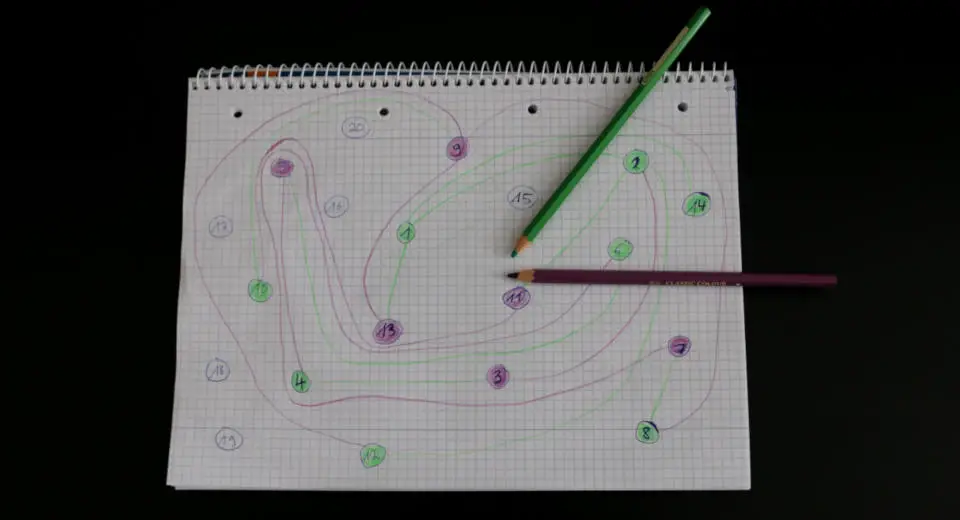Scramble, puzzle, logically deduce – not only “the big ones” have fun… For these 5 logic games for kids you need nothing but pens and paper!
Many kids show a special interest in logic from an early age and have fun with puzzles. And you can wonderfully playful promote by playing logic games with them. There are quite a few of these in the games trade, such as Knätsel*, NMBR9 the Brain Box Math for Kids or Ubongo, about which we also wrote a review, as well as its 3D Family version.
But for many logic games for kids, you need nothing more than pen and paper. We’ve compiled a list of our top ten logic games for kids with pen and paper below. And the best part: most of them are a lot of fun for adults, too!
The Top 5 Logic Games for Kids With Pen and Paper
We’ve roughly ranked the logic games for kids by ascending difficulty. All of the games in this list are for 2 players. Some of the logic games for kids require checkered paper, and some require different colored pens.
1. Tic-Tac-Toe

The classic game par excellence! To draw the game field of 9 boxes, you need just 4 strokes: two vertical, two horizontal. The two players now take turns placing an “X” or an “O” in the
boxes. The goal: the first player to create a row with 3 of his symbols wins. The row can be vertical, horizontal or diagonal.
Tic-Tac-Toe is suitable especially for smaller children. After a certain age it becomes too boring, because no one wins if both players think well enough.
2. Connect Four
The same basic principle, but with slightly more challenging rules. This is a game many readers may know as a buy game, where you set up a vertical wall with holes in front of you. But you can play it just as well with pencil on paper. First, draw a grid of 6 boxes in height by 7 boxes in width. This standard size can be varied at will.
Now 2 players take turns to mark a box with their symbol or with a pen of their color. However, these may not “float freely”, but must be stacked from the bottom of the board, just like in the physical Four Wins game. The first player to fill a row of 4 marked boxes (vertically, horizontally or diagonally) is the winner.
3. Battleship

Another schoolyard classic: to sink ships you need checkered paper. Each player now draws two 10 by 10 squares on their paper, labeled vertically with the numbers 1-10, and horizontally with the letters A-J. From now on, the players hold the sheets in such a way that the other player cannot see his or her own sheet.
In the left field you now draw your ships: one 4, two 3, three 3 and four 1. The ships may only lie vertically or horizontally, may not cross corners and may not touch each other, not even at the corners. The right field remains empty at the beginning and is used to locate and “shoot down” the opponent’s ships.
A player now starts to ask the opponent for coordinates, e.g. : “C7?”. If there is no ship at this position on the opponent’s side, he says “Nothing” or “Water”. Player 1 then records a dot at this point in his right field to remember that he has already “shot” here. It is then the other player’s turn to ask questions. If, however, a coordinate is guessed where a ship lies, the opponent must say “hit” and one records a cross there. The questioner in his right field, the hit in his left. If a hit also sinks the ship, the person hit says “hit sunk”.
The winner is the first to have sunk all the opponent’s ships.
4. Nim
This game is very old and exists in quite a few variants. It is usually played with a set of small objects, such as matches, which are taken away by the players in turn. Instead of this, it is also possible to simply draw several rows of vertical lines on a piece of paper. The pattern is as follows: 1 line in the first row, 2 in the second, 3 in the third, etc. You can also vary this and use only the odd numbers, i.e. 1, 3, 5, 7, etc. The number of lines can also be freely chosen. The number of rows is also freely selectable.
Now the players may take turns crossing out (= “taking away”) lines, as many as they like, but at least one. Another condition is that only lines in one row may be crossed out per turn. However, all (remaining) strokes in a row may also be taken.
The winner is the player who crosses out the last line. In the Misère variant, the reverse is true: the player who crosses out the last stroke or “picks up the last piece” loses.
The Nim game is very adaptable to different ages and difficulty levels due to its variable size and is well suited to practice logical and tactical thinking.
5. Dung Heap

This is also a game for 2 players. One writes on a sheet of paper the numbers from 1-20 distributed in a random order and circles them. Now both players take turns connecting the numbers with lines in ascending order. Each number that is reached may be colored with one’s own color and thus becomes one of the eponymous “dung heaps”.
You may not cross any of the lines when connecting the next number, but you may cross your own dung heaps. For each line and each opponent’s dung heap that you cross or touch, you get a penalty point.
The winner is the one who has the least penalty points at the end.
Optional additional rule: Some players go from the 20 arrived backwards again and the game then ends at the 1.
Much fun thinking and puzzling around!
Soon we will also publish a twin article about the 5 best logic games for adults with pen and paper. Now, if you’re looking for more good games to play at home, check out our variants of Who Am I? and Pantomime. And for all those in voluntary or prescribed quarantine, we have a whole 100 tips to combat boredom at home!
If you like the ideas on Greatime, give us a like on Facebook or check out on Instagram, that way you’ll also stay up to date on our latest articles!
*This article contains so-called referral links. This means that if you order products through them, we may receive a small commission without it costing you a penny more. 🙂

![5 Logic Games For Kids For Which You Only Need Pen And Paper [Uber En="Logic*games*for*kids*are*a*great*activity*for*all*children*who*love*logical*combinations*and*thinking." De="Logikspiele*für*Kinder*sind*eine*super*BEschäftigung*für*alle*Kinder,*die*logisches*Kombinieren*und*Nachdenken*lieben"]](https://greatime.de/wp-content/uploads/2020/05/logikspiele-fuer-kinder-titelbild.jpg)
![Uber En Quot Scopa Card Game Quot De Quot Hurrikan Kartenspiel Quot [Uber En="In*the*Scopa*card*game*it*depends*on*logical*thinking,*tactics*and*luck*to*win" De="Beim*Hurrikan-Kartenspiel*kommt*es*auf*logisches*Denken,*Taktik*und*Glück*an*um*zu*gewinnen"]](https://greatime.de/wp-content/uploads/2016/09/hurrikan-kartenspiel-spielanleitung.jpg)
![Uber En Quot Stars Of History Quot De Quot Stars Der Geschichte Quot [Uber En="Historical*figures*Quiz*for*adults*on*famous*people*and*stars*of*history" De="Quizfragen*für*Erwachsene*zu*berühmten*Personen*und*Stars*der*Geschichte"]](https://greatime.de/wp-content/uploads/2017/03/quizfragen-fuer-erwachsene-stars-der-geschichte.jpg)
![Uber En Quot The Legends Of Andor Quot De Quot Die Legenden Von Andor Quot [Uber En="The*Legends*of*Andor*board*game*is*the*perfect*game*for*fantasy-loving*team*players." De="Die*Legenden*von*Andor*ist*das*perfekte*Brettspiel*für*Fantasy-affine*Teamplayer."]](https://greatime.de/wp-content/uploads/2018/02/legenden-von-andor-cover.jpg)